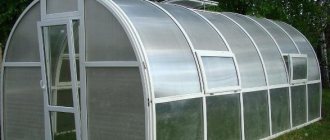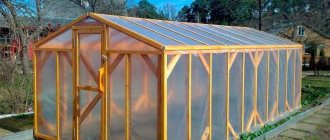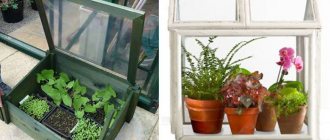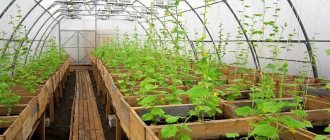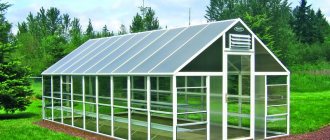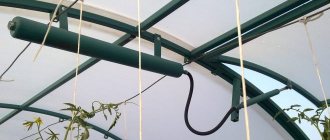A winter greenhouse is a useful structure for a plot of land that allows you to grow garden crops all year round. It is used both for personal needs and for growing fruit plants for sale.
The most versatile material for constructing greenhouses is polycarbonate. It is this that allows the use of the latest construction technologies, design developments and technical equipment for greenhouses.
Polycarbonate retains heat well and allows enough sunlight to pass through. Source plodogorod.com
Design differences between summer and winter greenhouses
The purpose of greenhouses is the same for any season - they are designed to protect plants and transfer them enough heat for growth and development. However, in terms of design, winter greenhouses differ significantly from summer buildings:
- Materials used for cladding the frame are resistant to loads, temperature changes and weather conditions. As a rule, this is glass or polycarbonate. In summer greenhouses there is enough durable film.
- Summer greenhouses warm up well during the day and the air does not have time to cool down overnight. In winter greenhouses, a heating system is required to maintain a comfortable temperature for growing.
- Winter buildings require insulation to avoid drafts and loss of thermal energy from the heating system.
- Summer greenhouses are often made in the form of arches; winter greenhouses require a gable roof so that snow does not accumulate on it.
Thus, summer greenhouses work exclusively due to natural factors - long daylight hours, solar heat, and a natural ventilation system. And in order to grow plants in winter, the necessary climatic conditions are artificially recreated in the greenhouse.
For light-loving plants it is necessary to create additional lighting Source tss.org.ru
Types of heating systems
Modern manufacturers offer many options for heating greenhouses. Based on their advantages and disadvantages, you can choose the most suitable system.
Stove heating
This is one of the simplest options for heating greenhouses in terms of design. The system consists of a stove, which is located in the vestibule, and a chimney laid along the entire length of the greenhouse. During combustion, smoke moves through the chimney, which transfers some of the heat to the plants and is discharged outside. Also, the most important element of this heating system is ventilation; without it, plants can smoke.
Advantages:
- simplicity of design;
- possibility of heating with any type of fuel;
- saving money.
Flaws:
- inability to ensure uniform heat distribution;
- possibility of temperature changes;
- strong heating of the furnace walls.
The last drawback can be eliminated if you use a special type of equipment - a solid fuel gas generator stove. This device has high heat dissipation. It quickly heats the entire area, but the surface of the oven remains cool. Using solid fuel stoves means you don’t have to be near the greenhouse all the time.
Biological heating
This method has been used since ancient times. Its essence lies in the fact that during the decay of organic substances, which are products of the vital activity of various microorganisms, heat is released. In this case, fertilizers, bark, sawdust or a mixture of these components are used as fuel.
Advantages:
- During decay, the air is humidified and carbon dioxide is released, which benefits the plants.
- No need to use any technical devices.
The main disadvantage: heating the greenhouse in winter using this method is only possible as an auxiliary one. Since in cold times the heat generated will clearly not be enough to maintain the optimal temperature.
Water heating
Currently, this option is one of the most popular solutions for heating greenhouses. To set up a water system you will need: a boiler, a tank, radiator and pipe systems, and a pump. Operating principle: water is heated in the boiler using electricity or kerosene and, under the action of a pump, moves throughout the heating system. The cooled water returns to the boiler. The cycle is repeated until the desired temperature in the greenhouse is reached.
Advantages:
- Uniform distribution of heating (for this it is necessary to place heating circuits at different levels of the greenhouse).
- Optimal humidity level in the greenhouse (the air is not too dry).
Flaws:
- high material costs;
- complex installation;
- the need to treat the system with anti-corrosion agents.
Gas heating
A good alternative to electric heating. To create such a system, you will need gas heaters and burners, which are placed throughout the entire area of the greenhouse for heating efficiency. Heat is released by burning gas directly in the greenhouse. Burners can be injection or infrared. When gas is burned, carbon dioxide and steam are released into the air. In small quantities they are necessary for plants, but in excess they can create a fire hazard. Therefore, special attention should be paid to ventilation systems.
Advantages:
- gas supply stability;
- rapid heating of the room;
- saving on combustible material.
The main disadvantage of gas heating systems is the need for vigilant monitoring to prevent gas leaks, which can lead to undesirable consequences for people and plants.
Air heating
This option is of little use for doing it yourself. An air heating system requires the knowledge and skills of professionals. It is constructed at the time of assembly of the greenhouse itself.
Advantages:
- high-quality uniform heating of the entire area of the greenhouse or greenhouse;
- no condensation.
Flaws:
- The difficulty of installing the system with your own hands.
- Drying the air. Therefore, constant monitoring of humidity levels is required. To do this, containers with water are often placed in the greenhouse.
Electric heating
At the moment, electric heating systems are in greatest demand among amateurs and professionals. They are quite effective and can be presented in various variations - convectors, heat guns, heating mats, electrical cables, etc. Technically more complex systems have special sensors and the ability to control various modes. Here's a quick rundown of the key elements to improve the efficiency of an electric heating system:
- Infrared heating. One of the most advanced ways to heat greenhouses. Heating a greenhouse with an infrared heater has a completely different principle than all other options. Its essence lies in heating not the entire volume of air in the greenhouse, but the specific locations of the plants. That is, heating occurs in individual areas where the plants are located and the soil from which they draw strength for growth. The greenhouse structure is also heated. All this eliminates the possibility of temperature changes and greatly simplifies the operation of the heating system. Using it, you can control and set the desired microclimate, turn on the heating limit and economical consumption.
- Convectors and convection systems. They are heating devices with spirals. They are installed in a greenhouse and, due to convection currents, heat the greenhouse area fairly evenly. The main disadvantages are that using convectors it is quite difficult to heat the soil and build a high-quality heating system on your own.
- Cables. This type of heating has 2 important advantages: it is inexpensive and works efficiently. This explains the great demand for cable heating. Installing the cables is also very simple: tapes of a certain power are laid in the ground around the perimeter of the greenhouse. The cables can also be installed on the outside of the greenhouse walls. This will provide protection from cold getting inside the building.
- Heaters. Inexpensive compact mobile devices. They heat the greenhouse evenly, but dry out the air, which is very undesirable for plants. Typically, air heaters are equipped with thermostats that allow you to adjust the desired microclimate mode.
- Heat pump. Quite an effective device for heating a greenhouse. Its peculiarity lies in the processing of heat from natural energy. Various types of pumping systems such as “air”, “water”, “soil” are installed in greenhouses. This provides the plants with the necessary amount of heat. Such a greenhouse with your own hands all year round is expensive, but quickly pays for itself due to the high yield, as well as the lack of the need to spend money on heating air and water in the future.
High-quality heating of a greenhouse will allow you to enjoy fresh vegetables all year round, and, if the scale is appropriate, you will be able to organize your own agribusiness.
Polycarbonate in the construction of winter greenhouses
The use of polycarbonate in the construction of winter greenhouses is due to its strength and light transmission qualities. The advantages of this material are the following:
- resistance to mechanical damage;
- good aesthetic characteristics;
- light weight of the structure - suitable for any frame;
- conducts sunlight well;
- ease of processing and installation of sheets;
- the material can withstand heavy loads - important when there is a lot of snow in winter;
- tolerates strong heating and cooling, does not deteriorate under the influence of UV rays.
All these factors make polycarbonate an ideal material for the construction of winter greenhouses. It perfectly protects plants from snow and frost and allows you to maintain the correct microclimate in the building.
In a greenhouse, heat-loving plants are not afraid of early frosts Source neldekstop.ru
Greenhouse design options
The construction market offers a huge selection of shapes and sizes of greenhouses. Therefore, customers always have the opportunity to make it to suit their own needs. When choosing a design, it is worth considering the type and number of plants that you plan to grow in the greenhouse.
A heated winter greenhouse can be quite long or wide. For private land plots, there are standard dimensional grids for turnkey structures.
The base of the greenhouse is usually rectangular or square. The roof is made in various forms:
- arcuate;
- single slope;
- gable;
- multi-level.
The main condition for the roof of a winter greenhouse is the presence of a slope so that snow can slide off it under the weight of its own weight and not accumulate on the roof. It is also recommended to make vents in the roof to ventilate the structure.
Vents in greenhouses are most often located at the top point of the roof Source oteplicah.com
Greenhouses, as a rule, consist of one “room”, but experts recommend organizing a heated dressing room. This is done so that with frequent use in winter, the plants do not suffer from the penetration of cold air from the street.
See also: Catalog of companies that specialize in the installation of metal structures.
Purpose
The main purpose of the design is to obtain a harvest of fresh vegetables and herbs at home throughout the house. Inside, the device creates an optimal microclimate necessary for normal growth and development of plants.
A greenhouse helps not only to grow plants at home, but also to prepare seedlings for the new season for further planting on the site.
A greenhouse helps not only to grow plants at home, but also to prepare seedlings
Stages of construction of polycarbonate greenhouses
The construction of a winter greenhouse made of polycarbonate is a rather complex technological process. It consists of several stages that affect both the construction of the structure itself and its internal equipment. Therefore, it is better if a turnkey winter greenhouse with heating is built by experienced hands.
Foundation
A polycarbonate winter greenhouse has a heavy structure and will require laying a foundation to give it stability. It can be one of three types:
- lumber;
- stone;
- brick;
- tape
The latter option is most often used in the construction of permanent greenhouses. Laying a strip foundation is carried out in several stages:
- marking the construction site, digging a trench approximately 1 m deep;
- laying waterproofing at the bottom of the trench;
- installation of reinforcement to strengthen the foundation;
- filling the trench with gravel-sand-cement mortar;
- laying heat-insulating material on a dried strip foundation.
After preparing the foundation, anchor bolts are installed into it for subsequent fastening of the frame. Sometimes a layer of brick is laid on the foundation, in which case the fasteners must pass through the masonry and penetrate into the foundation.
Arrangement of a strip foundation for a greenhouse Source arka-green.ru
Frame installation
To build a frame under polycarbonate sheets, metal profiles, pipes and corners are most often used. This choice is due to the strength and durability of the metal base compared to wood.
Installation of the frame is carried out in several stages:
- securing the bottom lining to the foundation using anchor bolts;
- installation of vertical posts on the casing using bolts or welding;
- connection of vertical profiles with horizontal lining at the top;
- installation of a frame under a pitched roof.
The integrity and strength of the entire greenhouse structure depends on the correct installation of the base. Therefore, it is carried out exactly according to the planned plan and calculations.
The finished frame for the greenhouse remains to be sheathed with polycarbonate sheets Source homeli.ru
Final works
Greenhouses for year-round use require a rafter system that is nailed to a support. After this, the jumpers can be removed. A ridge beam should be installed under the rafters. Now the front supports are placed under it. Their size is 880 millimeters. Greenhouses for year-round use with heating require the installation of a stove at the last stage, which is preferably located in the vestibule.
- Year-round greenhouse - myth or reality
- Installation of transparent greenhouses for use all year round
- Installation of a polycarbonate greenhouse
- Construction of a year-round mixed greenhouse
- Heating systems for greenhouses
- Additional lighting for greenhouses
